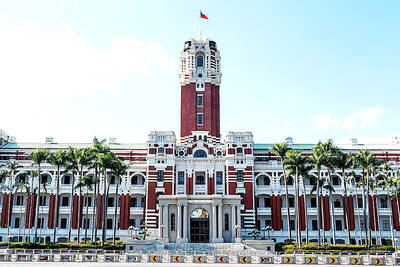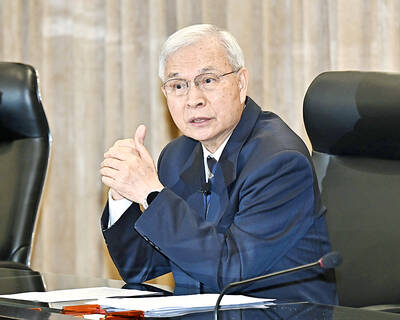The US has successfully conducted another flight test of the Aegis Ballistic Missile Defense (BMD) system, intercepting a medium-range ballistic missile over the Pacific near Hawaii.
Senior fellow at the International Assessment and Strategy Center Rick Fisher said on Wednesday that the timing of the test “cannot be ignored.”
It was significant, he said, that the test was conducted after North Korea’s third nuclear test, its reported imminent test of a new ballistic missile and China’s “aggressiveness” in the East China Sea.
“A robust American missile defense capability is directly relevant to the security of Taiwan, Japan and South Korea in that it deters both North Korea and China by creating doubt about the success of their missiles,” Fisher said.
However, Fisher stressed that a purely missile defense strategy for Taiwan — or the US — was being made untenable by China’s and North Korea’s growing missile arsenals.
“It is simply too expensive for the defender to deter the numbers of missiles China and North Korea can produce,” he said.
It would be far more efficient, he said, to build offensive missiles that could hold Chinese and North Korean assets at risk “much as they are doing to the democracies in Asia.”
Fisher said that Washington had “quietly” changed its previous caution about allied Asian offensive missile capabilities.
He said it now needed to help “rationalize” new allied offensive missile capabilities if non-nuclear deterrence was to survive in Asia into the next decade.
The latest BMD test was carried out by US Navy sailors aboard the USS Lake Erie using a Standard Missile-3 (SM-3) Block 1A guided missile.
A target ballistic missile was launched from the Pacific Missile Range Facility on Kauai, Hawaii.
An in-orbit tracking system detected and tracked the target and the second-generation Aegis BMD weapon was launched five minutes later.
“The SM-3 maneuvered to a point in space and released its kinetic warhead,” a statement from the US Department of Defense said.
“The kinetic warhead acquired the target re-entry vehicle, diverted into its path, and, using only the force of a direct impact, engaged and destroyed the target,” the statement said.
“Initial indications are that all components performed as designed,” the Department of Defense said.
The Department of Defense said that the test was a demonstration of the ability of space-based “assets” to provide mid-course fire control quality data to an Aegis BMD ship “extending the battlespace, providing the ability for longer-range intercepts and defense of larger areas.”
It was the 24th successful intercept in 30 flight test attempts for the Aegis BMD program since flight testing began in 2002.

The CIA has a message for Chinese government officials worried about their place in Chinese President Xi Jinping’s (習近平) government: Come work with us. The agency released two Mandarin-language videos on social media on Thursday inviting disgruntled officials to contact the CIA. The recruitment videos posted on YouTube and X racked up more than 5 million views combined in their first day. The outreach comes as CIA Director John Ratcliffe has vowed to boost the agency’s use of intelligence from human sources and its focus on China, which has recently targeted US officials with its own espionage operations. The videos are “aimed at

STEADFAST FRIEND: The bills encourage increased Taiwan-US engagement and address China’s distortion of UN Resolution 2758 to isolate Taiwan internationally The Presidential Office yesterday thanked the US House of Representatives for unanimously passing two Taiwan-related bills highlighting its solid support for Taiwan’s democracy and global participation, and for deepening bilateral relations. One of the bills, the Taiwan Assurance Implementation Act, requires the US Department of State to periodically review its guidelines for engagement with Taiwan, and report to the US Congress on the guidelines and plans to lift self-imposed limitations on US-Taiwan engagement. The other bill is the Taiwan International Solidarity Act, which clarifies that UN Resolution 2758 does not address the issue of the representation of Taiwan or its people in

US Indo-Pacific Commander Admiral Samuel Paparo on Friday expressed concern over the rate at which China is diversifying its military exercises, the Financial Times (FT) reported on Saturday. “The rates of change on the depth and breadth of their exercises is the one non-linear effect that I’ve seen in the last year that wakes me up at night or keeps me up at night,” Paparo was quoted by FT as saying while attending the annual Sedona Forum at the McCain Institute in Arizona. Paparo also expressed concern over the speed with which China was expanding its military. While the US

SHIFT: Taiwan’s better-than-expected first-quarter GDP and signs of weakness in the US have driven global capital back to emerging markets, the central bank head said The central bank yesterday blamed market speculation for the steep rise in the local currency, and urged exporters and financial institutions to stay calm and stop panic sell-offs to avoid hurting their own profitability. The nation’s top monetary policymaker said that it would step in, if necessary, to maintain order and stability in the foreign exchange market. The remarks came as the NT dollar yesterday closed up NT$0.919 to NT$30.145 against the US dollar in Taipei trading, after rising as high as NT$29.59 in intraday trading. The local currency has surged 5.85 percent against the greenback over the past two sessions, central